Capacitive circuits
Following are information and questions on capacitive circuits.
Instructions:
For the multi-choice questions:
- choose the correct answer
- write down your answer.
For the calculation questions:
- calculate the unknown value
- specify the appropriate unit
- write down your answer.
Note:
- You can print this page and write your answers onto it.
- You can use a calculator.
Safety
Capacitors can retain their electric charge for a long period of time. For this reason they present a personal danger.
Extreme care must be taken with:
- circuits that have been turned off, but contain a charged capacitor
- capacitors that have been removed from a circuit or device.
A resistive bridge circuit should be connected across a capacitor to ensure it is discharged and safe before handling.
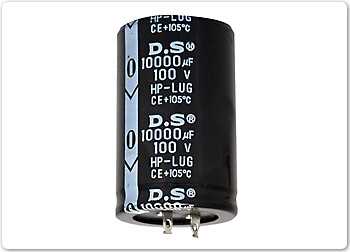
Question 1
Multiple choice question
What should you do before handling a capacitor that has been removed from a circuit?
- Connect the capacitor to a power supply.
- Check the farad rating of the capacitor.
- Bridge out the capacitor terminals with a resistive circuit.
Capacitors in parallel
Placing a number of capacitors in parallel has the same effect as increasing the plate area of one capacitor.
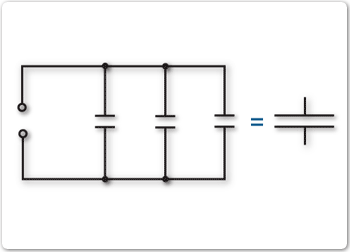
Therefore placing capacitors in parallel increases the total capacitance of a circuit.
Calculating parallel capacitance
The following formula is used to calculate total capacitance in a parallel circuit.
CTotal = C1 + C2 + C3
Example
For the following circuit diagram:

Ctotal = C1 + C2 +C3
Ctotal = 3µF + 6µF + 12µF
Ctotal = 21µF
Question 2
Multiple choice question
How will the total capacitance of a circuit change if capacitors are added in parallel to the circuit?
- Total capacitance will increase
- Total capacitance will decrease
- Total capacitance will remain the same
- It depends on the value of the added capacitor
Question 2
For the following circuit diagram, calculate the total capacitance value of the circuit.
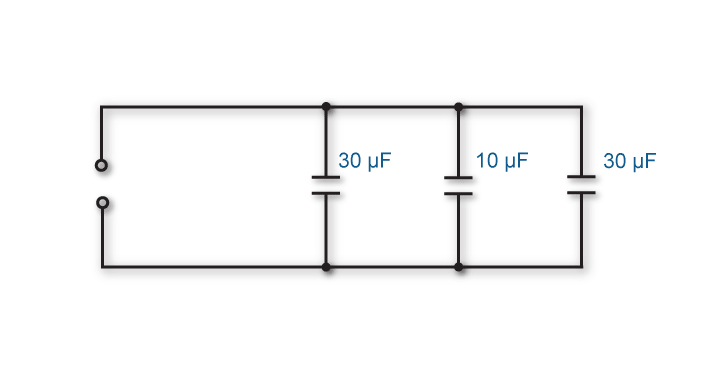
Capacitors in series
Placing a number of capacitors in series has the effect of increasing the distance between plates of a capacitor.

Therefore placing capacitors in series decreases the total capacitance of a circuit.
Calculating series capacitance
The following formula is used to calculate total capacitance in a series circuit.
1/CT = 1/C1+ 1/C2 + 1/C3
Example
For the following circuit diagram:

1/Ct = 1/C1+ 1/C2 + 1/C3
1/Ct = 1/30 + 1/10 + 1/30
1/Ct = 1/30 +3/30 + 1/30
1/Ct = 5/30
Ct/1= 30/5
Ct = 6µF
Question 3
Multiple choice question
How will the total capacitance of a circuit change if capacitors are added in series to a circuit?
- Total capacitance will increase.
- Total capacitance will decrease.
- Total capacitance will remain the same.
- It depends on the value of the added capacitor.
Question 4
For the circuit diagram shown, calculate the total capacitance value of the circuit.
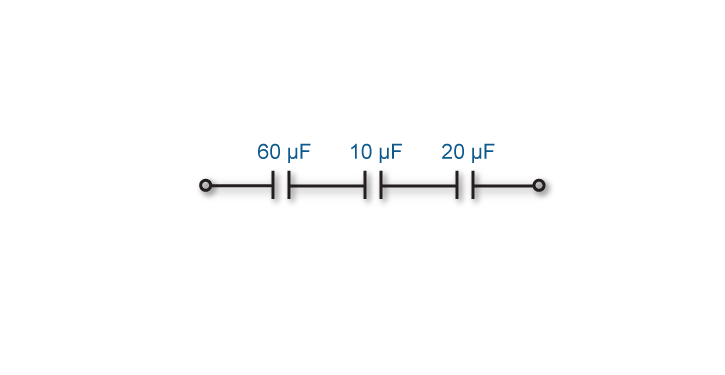
Capacitor faults
The following faults can occur to a capacitor:
- short circuit
- open circuit
- capacitance loss.
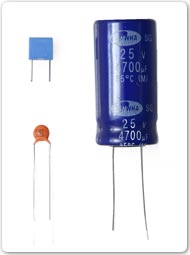
Short circuit:
- this can occur if there is a breakdown of the dielectric and an electrical connection exists between the plates.
Open circuit:
- an open circuit can occur if there is a break in the lead connecting to either plate of the capacitor.
Capacitance loss:
- caused by dielectric current leakage between the plates. This results in a reduction of capacitance.
Question 5
An open circuit can exist in a capacitor when there is a fault with the dialectic material.
- True.
- False.
When you have finished:
- show your answers to your trainer
- close this window and choose a new activity from the menu.